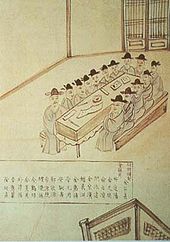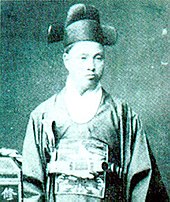Gabo reforms
| Gabo reform | |
|---|---|
| Korean alphabet : | 갑오 개혁 |
| Hanja : | 甲午 改革 |
| Revised Romanization : | Gabo Gaehyeok |
| McCune-Reischauer : | Kabo Kaehyŏk |
The Gabo Reforms are a series of reforms in Korea under the Joseon Dynasty from 1894 to 1896 under the reign of King Gojong . Begun during the Sino-Japanese War , these reforms were a response to the Donghak uprising and affected large areas of politics and society. The reforms were mainly of progressive Koreans as Kim Hong-jip and returnees from exile in Japan , as Seo Jae-pil and already on gapsin coup involved Pak Yeong-hyo , worn. The name Gabo ( 갑오 ) is derived from the year name for the year 1894 in the Chinese 60-year cycle.
background
In the previous decade, Japan and China had courted supremacy in Korea. When Korea seemed on the verge of collapse after the outbreak of the Donghak uprising , the Japanese Meiji government decided to intervene on the Korean Peninsula . The Donghak uprising therefore led directly to the First Sino-Japanese War. At the same time as the military crackdown on China in Korea, the Japanese leadership intended, with the help of Korean collaborators, to carry out fundamental reforms to the political and social system in Korea, based on the Japanese reforms during the early Meiji period .
Reforms
The Gabo reforms can be roughly divided into three phases, which were supported by different protagonists and characterized by a different degree of Japanese involvement.
First phase
Between July and December 1894, at the suggestion of the Japanese ambassador Ōtori Keisuke , the newly created "Military Advisory Committee" ( Gunguk Gimucheo ) submitted a whole series of reform laws to the Korean King Gojong for signature: class differences, slavery and the traditional official examinations were abolished. The government was restructured on the Japanese model; In addition to a State Council, eight ministries (interior affairs, finance, etc.) were created. A stable currency was introduced and tax collection reformed. Furthermore, that was collective punishment abolished, the marriages with minors prohibited and the remarriage of widows allowed.
Second phase
Dissatisfied with the progress of the reforms, the Japanese government replaced Ōtori in late 1894 with Inoue Kaoru , who dissolved the Gunguk Gimucheo and installed a new cabinet under Kim Hong-jip and the advocate of radical reforms, Pak Yeong-hyo, which installed the Announced the end of the centuries-old tribute relationship with China. During this phase, a uniform judicial system was created and the police and the military were reorganized and modernized. Inoue also placed Japanese advisors in the newly created ministries and in the army to further consolidate the Japanese position and oversee reforms. He also tried to limit the influence of the anti- Japanese Queen Min faction in the Korean royal court. Inoue also pushed for economic concessions to Japan, which, however, provoked protests in Korea and also made Inoue's Korean allies at a distance from him.
The second phase of reforms was interrupted when the second cabinet of Kim Hong-jip broke up because of the intrigues of Pak and Pak was forced to flee to Japan.
Third phase
The new cabinet, once again headed by Kim Hong-jip, undertook further reforms between August 1895 and February 1896. So the cabinet decided to introduce the Gregorian calendar and a modern school system as well as the establishment of a postal service.
The ban on the hair knot tied together on the head ( 斷 , 斷 髮 anb , danballyeong ), the traditional hairstyle of married men, passed at the end of 1895 , however, met with bitter resistance from the population. The decree and news of the murder of Queen Min caused protests in the country to escalate.
Impact and Importance
Against the background of the uncertain situation, King Gojong finally decided on February 10, 1896 to flee from his palace to the Russian embassy. Shortly after the king's flight, Prime Minister Kim Hong-jip, branded as a traitor , and two other members of his cabinet were lynched by an angry mob on the streets of Seoul. After Shimonoseki's intervention , the Russian Empire was able to increase its influence and took a dominant position in Korea over the next few years.
The Gabo reforms were the first serious attempt to transform Korea into a strong and modern nation. Begun under Japanese aegis, the modernization aimed to create a political basis for a Japanese protectorate over Korea. The reforms, which continued even after the failure of the Japanese attempt to secure its supremacy in Korea, were at the same time an expression of the will to modernize among 'enlightened' Korean scholars and functional elites.
Individual evidence
- ↑ Gabo reforms ( Memento of the original from June 10, 2011 in the Internet Archive ) Info: The archive link was inserted automatically and has not yet been checked. Please check the original and archive link according to the instructions and then remove this notice. on Nate Britannica Korea (Korean)
- ↑ Peter Duus: The Abacus and the Sword. The Japanese Penetration of Korea, 1895-1910 , Berkeley 1995, p. 72
- ^ Bruce Cumings: Korea's Place in the Sun. A Modern History , New York 2005, p. 120
- ↑ Moriyama Shigenori: Kindai Nikkan Kankeishi Kenkyû. Chôsen Shokuminchika to Kokusai Kankei , Tôkyô: Tôkyô University Publishing House, third edition, 2001
- ↑ Eggert / Plassen: Little History of Korea , Munich 2005, p. 121
- ↑ Peter Duus: The Abacus and the Sword. The Japanese Penetration of Korea, 1895-1910 , Berkeley 1995, p. 118



